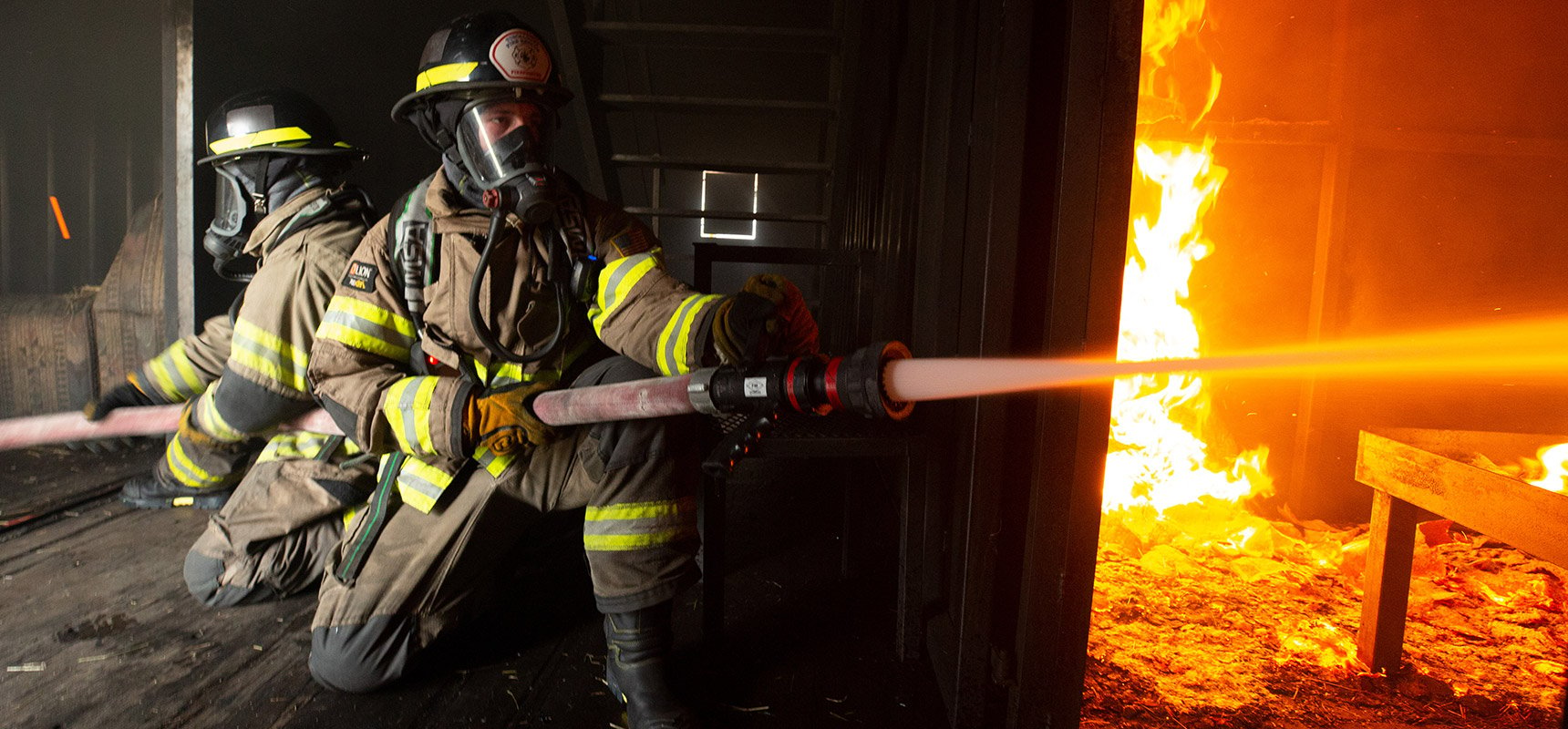
There's nothing quite like a discussion about fire hose nozzles to get a group of firefighters heated up.
If you ask their preference between a fog tip nozzle and a straight tip nozzle, you can expect a highly contentious discussion and very firm lines drawn in the sand.
At Pierce Manufacturing, our goal is to provide education on each type of nozzle and the commonly discussed pros and cons of each.
What is a Fire Hose Nozzle?
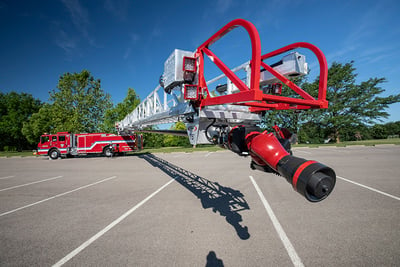 A nozzle is used to define how water will be applied to a fire. Fire truck nozzles are part of the master stream devices that are mounted to the truck or the aerial device to provide water support in firefighting operations.
A nozzle is used to define how water will be applied to a fire. Fire truck nozzles are part of the master stream devices that are mounted to the truck or the aerial device to provide water support in firefighting operations.
How is a fire hose nozzle selected?
Nozzle selection is determined by each fire department according to their standard operating procedures and policies. Nozzles are intended to support optimal fireground operations and match the mission of the truck. Nozzles can be used based on the application required and to manage different types of call scenarios.
It is not uncommon for fire trucks in the same fleet to be equipped with different types of nozzles. For example, an initial attack pumper may include a straight tip nozzle so it can arrive on the scene and initiate fire suppression tasks immediately, while a ladder truck may be equipped with a fog nozzle to provide secondary support and focus on exposure protection.
Each type of nozzle has its own advantages and design specifications intended to support optimal firefighting capabilities. Let’s compare these fire truck nozzles in detail.
What is a Straight Tip Nozzle?
A straight tip nozzle provides firefighters with a stream of solid water that is not altered during flow. Stack tips can be added to the nozzle to increase pressure and narrow the stream of water for greater reach or removed from the nozzle to widen the stream of solid water.
Advantages of Using a Straight Tip Nozzle
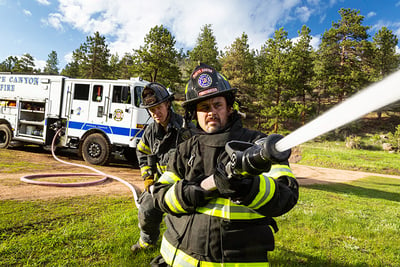
Straight tip nozzles are ideal when precise delivery of water is required and when reach and penetration are the top priorities.
- Precise delivery of water with extended reach and penetration. With an unaltered stream of solid water, emergency responders can position the pumper or aerial at a specified distance from the structure and reliably aim water at the structure. The straight tip nozzle provides precise water delivery across the street and over parked cars without disrupting or soaking anything beneath the stream.
- A straight stream of water. Some firefighting tasks require a straight stream of steady water, and a straight tip nozzle meets those requirements.
- Adjustable stack tips to extend or widen the stream of water. Stack tips can be added or removed from a straight tip nozzle. These narrow and widen the flow of water, which helps to manage the overall reach and penetration of the stream of water.
- Simple design with no mechanical parts. A straight tip nozzle has one valve that controls the water. It is always running at full boar—operators are just tasked with aiming the stream appropriately. A manual lever is used to raise the nozzle up and down and turn the nozzle left and right.
Disadvantages of Straight Tip Nozzles
Fire departments that use straight tip nozzles will often find no faults with the nozzle design and operation, but here are a few of the drawbacks fog tip nozzle users often cite.
- Limited flexibility as fire conditions change. Fire conditions can change quickly, and some operators feel that straight tip nozzles do not offer the flexibility to adapt.
- Inability to manage gross decontamination events. A straight tip nozzle is not safe to manage effectively for decontamination needs
- Less effective exposure protection. While a straight tip nozzle can provide exposure protection, it does not offer a wide breadth of water stream coverage.
What is a Fog Nozzle?
A fog nozzle breaks up the stream of flowing water to create droplets that disperse the water outward. Instead of a solid, steady stream of water, a fog nozzle creates a wider cast of water.
Advantages of Using a Fog Nozzle
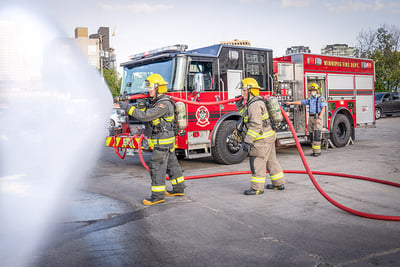 A fog nozzle is ideal to manage the flow of water when a wider spray of water is required. This can include:
A fog nozzle is ideal to manage the flow of water when a wider spray of water is required. This can include:
- Exposure protection. One of the most touted attributes of the fog nozzle is its ability to blanket a large area with a steady blanket of water. Exposure protection is used to wet buildings, vegetation or areas adjacent to a fire to prevent the fire from spreading.
- The ability to assist with gross decontamination on scene. When firefighters or individuals are exposed to toxins at an emergency scene, they can walk through an overhead downstream of water from a fog nozzle to remove toxins.
- Water curtain and vapor control capabilities. As the name implies, fog nozzles are great at creating fog or mist. This can be beneficial to set up a wide fog to disperse vapors from a gas line leak or to create a stream of water between buildings to provide exposure protection.
- Flexibility to manage the width of the stream. The fog pattern of a fog nozzle can be altered by the operator. The nozzle can spray a long steady stream to attain penetration and reach, but there will still be some droplets created and a wider coverage area.
- Remote operation and autonomous control capabilities. A fog nozzle can operate from a pedestal or another location, and firefighters can use autonomous controls from a distance.
- Equipped with a swiveling motor. A fog nozzle has a motor that allows the device to open and close, move, and swivel up and down, and that allows the fog nozzle to turn and rotate in the tower, at the end of an aerial or on the pedestal.
Disadvantages of the Fog Nozzle
Fire departments that love fog nozzles will never say there are disadvantages, but here are a few of the areas that straight tip nozzle enthusiasts highlight as shortcomings.
- The perception of never achieving a straight, steady stream. Because of how a fog nozzle breaks up water into droplets, some operators believe that there will never be a straight, solid stream of water.
- The reach is affected by the width of the stream. The fog nozzle water stream can be adjusted to expand the width, but as this happens, the reach decreases.
- No adjustable tips. Unlike a straight stream nozzle, a fog tip nozzle does not offer the ability to change tips or adjust the amount of water flowing through the nozzle.
- Moving parts to maintain. A fog tip nozzle includes a motor and moving parts, which require regular maintenance to achieve optimal performance.
Fire Truck Nozzle Selection Key Takeaways
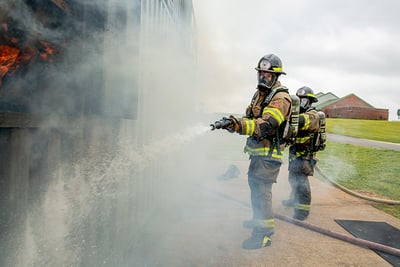 Each type of fire hose nozzle has its redeeming qualities that firefighters love. Keep these takeaways in mind regardless of which type you choose for your next fire apparatus.
Each type of fire hose nozzle has its redeeming qualities that firefighters love. Keep these takeaways in mind regardless of which type you choose for your next fire apparatus.
- Know what is installed in your vehicle. Have a thorough understanding of the type of nozzle on your fire truck and how to operate it effectively.
- New equipment may not operate like your old equipment. As technology changes, nozzles are becoming more sophisticated and operational procedures and pressure requirements may change.
- Remain flexible and focused on the truck’s mission. If the mission of your truck changes, be flexible and consider the benefits of each nozzle to best support the community and call types.
- Prioritize training. Understanding how to operate the nozzles on all the trucks in your fire station is important. Make sure firefighters are routinely trained on nozzle operations to ensure efficient fireground operations.
At the end of the day, both a fog nozzle and a straight tip nozzle offer firefighters tremendous diversity and functionality in firefighting operations.
Are you #TeamStraightTipNozzle or #TeamFogNozzle? We can’t wait to see your comments and thoughts!